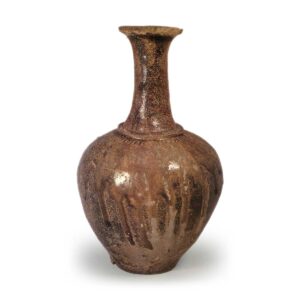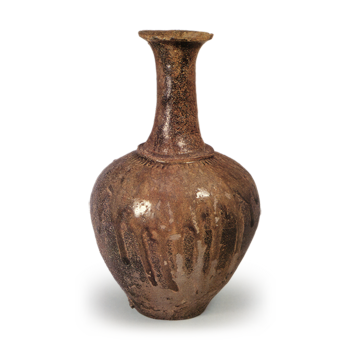
Excavated from the site of Nishi-Shiinokiyama Kiln, Itayama-cho, Handa-shi, Aichi
12th century
Height 27.3 cm, mouth diameter 6.9 cm, body diameter 16.0 cm, bottom diameter 6.5 cm
Early Tokoname ceramics most closely followed the tradition of the Sanage kiln ash glaze pottery of the previous generation. The most representative example is this water bottle. Although the thin, straight neck and the flat bottom have been replaced by a flat base, the oval-shaped body with a stout shoulder is still very much in the shape of water bottles produced since the end of the Nara period.
The technique of attaching a single band to the joint between the neck of the mouth and the shoulder began in the late 12th century, and was widely used on jars and bottles in the first half of the 12th century. Another characteristic of early Tokoname ware is the bordering of the shoulder with an engraved line. It is made of iron-rich, slightly low refractory clay and fired with oxidized iron, resulting in a slight distortion of the overall firing. The firing is very good, with a greenish-brown glaze covering part of the neck and the entire surface of the shoulder, which flows down to the lower half of the body, enhancing the appearance of this water jar. The ash glaze technique is still in use in early Tokoname, and whether the ash glaze on this water jar is natural or artificial is a point that needs to be examined. In any case, this is one of the most beautiful examples of early Tokoname pottery.



